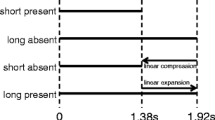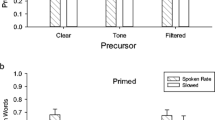Abstract
Speech can be described either in terms of acoustics, as a perceptual outcome, or as a motor event. Central to theories of speech perception and production is an attempt to describe how these aspects of speech are interrelated. The present experiment investigated how the nonstutterers' and stutterers' reproductions of acoustically presented interrogative sentences were influenced by experimental variations of intonation (sentence initial vs. sentence final) and speech rate (normal vs. time compressed). We studied the effects of these stimulus manipulations on the speech rate and fundamental frequency (F0 ) of 10 adult German-speaking nonstutterers and seven stutterers. Experimental manipulations of intonation and speech rate significantly influenced the syllable duration and speech rate of both normal speakers and stutterers. The fundamental frequency of the subjects' responses were also significantly influenced by the intonation of the stimulus. But the stutterers' increase in F0 for stressed syllables was generally less pronounced than that of nonstutterers. These results imply that (a) the subjects not only extract linguistic meaning from intonation but that they also store extragrammatical speech rate information, and (b) the speakers adopt these speech rate variations for their own productions. Generally, these results demonstrate that speech perception is not limited to extracting linguistically invariant information. The results show that speakers actively generate their own prosody and that this generative process is influenced by the prosodic structure of another speaker's antecedent speech. The implications of these results for theories of speech production are discussed.
Similar content being viewed by others
REFERENCES
Argyle, M. (1969). Social interaction. London, England: Methuen.
Batliner, A. (1991). Fokus, Deklination und Wendepunkt. In H. Altmann, A. Batliner, & W. Oppenreider (Eds.), Zur Intonation von Modus und Fokus im Deutschen (pp. 71–86). Tübingen, Germany: Narr Verlag.
Bergmann, G. (1986). Studies in stuttering as a prosodic disturbance. Journal of Speech and Hearing Research, 29, 290–300.
Black, J. W. (1949). Loudness of speaking: The effect of heard stimuli on spoken responses. Journal of Experimental Psychology, 39, 311–315.
Bock, K. (1986). Syntactic persistence in language production. Cognitive Psychology, 18, 355–387.
Bock, K., & Loebell, H. (1990). Framing sentences. Cognition, 35, 1–40.
Bosshardt, H. G. (1990). Subvocalization and reading rate differences between stuttering and nonstuttering children and adults. Journal of Speech and Hearing Research, 33, 776–785.
Bosshardt, H. G. (1993). Differences between stutterers' and nonstutterers' short-term recall and recognition performance. Journal of Speech and Hearing Research, 36, 286–293.
Bosshardt, H. G., & Fransen, H. (1996). On-line sentence processing in adults who stutter and adults who do not stutter. Journal of Speech and Hearing Research, 39, 785–797.
Bosshardt, H. G., & Hagen, B. (1986). Einfluss der englischsprachigen Textoberfläche auf ihre deutsche Übersetzung. Archiv für Psychologie, 140, 127–136.
Bosshardt, H. G., & Meyer, A. (1985). Experimentelle Untersuchung des Simultandolmetschens: Einheitenbildung und zeitliche Koordination. Archiv für Psychologie, 137, 137–157.
Bosshardt, H. G., & Nandyal, I. (1988). Reading rates of stutterers and nonstutterers during silent and oral reading. Journal of Fluency Disorders, 14, 407–420.
Buller, D. B., & Aune, R. K. (1988). The effects of vocalics and nonverbal sensitivity on compliance: A speech accommodation theory explanation. Human Communication Research, 14, 301–332.
Buller, D. B., & Aune, R. K. (1992). The effects of speech rate similarity on compliance: Application of communication accommodation theory. Western Journal of Communication, 56, 37–53.
Cooper, W. E., & Paccia-Cooper, J. M. (1980). Syntax and speech. Cambridge, MA: Harvard University Press.
Fant, G. (1990). The speech code: Segmental and prosodic features. Proceedings of the Conference on Spoken Language Processing, Kobe, Japan (pp. 1389–1397).
Feldstein, S. (1972). Temporal patterns of dialogue: Basic research and reconsiderations. In A. W. Siegman & B. Pope (Eds.), Studies in dyadic communication. New York: Pergamon Press.
Ferreira, F. (1993). Creation of prosody during sentence production. Psychological Review, 100, 233–253.
Franken, M. C., Boves, L., Peters, H. F. M., & Webster, R. L. (1991). Prosodic features in the speech of post-therapy compared with the speech of nonstutterers. In H. F. M. Peters, W. Houstijn, & C. W. Starkweather (Eds.), Speech motor control and stuttering (pp. 527–534). Amsterdam: Exerpta Medica.
Giles, H. (1973). Communicative effectiveness as a function of accented speech. Speech Monographs, 40, 330–331.
Giles, H., & Coupland, N. (1991). Language: Contexts and consequences. Milton Keynes: Open University Press.
Giles, H., & Powesland, P. E. (1975). Speech style and social evaluation. London, England: Academic Press.
Grimm, H. (1983). Kognitions-und interaktionspychologische Aspekte der Entwicklungsdysphasie. Sprache & Kognition, 3, 169–186.
Jäncke, L. (1993). Stottern eine psychologische oder physiologische Störung? In H. S. Johannsen & L. Springer (Eds.), Stottern, Tagungsbericht, Münster 1993 43–59). Ulm, Germany: Phoniartrische Ambulanz.
Jäncke, L. (1994). Variability and duration of voice onset time and phonation in stuttering and nonstuttering adults. Journal of Fluency Disorders, 19, 21–38.
Jäger, A. O., & Althoff, K. (1983). Wilde-Intelligenz-Test (WIT): Ein Strukturdiagnostikum. Göttingen, Germany: Hogrefe, Verlag für Psychologie.
Jakobson, R., & Halle, M. (1956). Fundamentals of language. The Hague, The Netherlands, Mouton.
Kalveram, K. H. (1991). How pathological audio-phoniatric coupling induces stuttering: A model of speech flow control. In H. F. M. Peters, W. Hulstijn, & C. W. Starkweather (Eds.), Speech motor control and stuttering (pp. 163–170). Amsterdam: Exerpta Medica.
Karniol, R. (1995). Stuttering, language, and cognition: A review and a model of stuttering as suprasegmental sentence plan aliguement (SPA). Psychological Bulletin, 117, 104–124.
Klatt, D. H., & Stefanski, R. A. (1974). How does a mynah bird imitate human speech? Journal of Acoustic Social America, 55, 822–832.
Knipschild, M., & Sappok, C. (1991). Akustische Zeichenverarbeitung durch SONA und VERSTEU. Fortschritte der Akustik-DAGA, (pp. 1045–1048). Bad Honnet: DGP-GmbH.
Lehrl, S. (1976). Manual zum MWT-B. Erlangen, Germany: Verlag Dr. med. D. Straube.
Levelt, W. J. M. (1989). Speaking: From intention to articulation. Cambridge, MA: MIT Press.
Levelt, W. J. M., & Kelter, S. (1982). Surface form and memory in question answering. Cognitive Psychology, 14, 78–106.
Lieberman, A. M., & Mattingly, I. G. (1985). The motor theory of speech perception revised. Cognition, 21, 1–36.
Natale, M. (1975). Convergence of mean vocal intensity in dyadic communications as a function of social desirability. Journal of Personal and Social Psychology, 32, 790–804.
Neilson, P. D., Neilson, M. D., & N. J. O'Dwyer (1992). Adaptive model theory: Application to disorders of motor control. In J. J. Summers (Ed.), Approaches to the study of motor control and learning (pp. 495–547). Amsterdam: Elsevier.
Perkins, W. H., Kent, R. D., & Curlee, R. F. (1991). A theory of neuropsycholinguistic function in stuttering. Journal of Speech and Hearing Research, 34, 734–752.
Peters, H. F. M., Hulstijn, W., & Starkweather, C. W. (1989). Acoustic and physiological reaction times of stutterers and nonstutterers. Journal of Speech and Hearing Research, 32, 668–680.
Pisoni, D. P. (1990). Effects of talker variability on speech perception: implications for current research and theory. Proceedings of the Conference on Spoken Language Processing, Kobe, Japan (pp. 1399–1407).
Postma, A., & Kolk, H. (1993). The covert repair hypothesis: Prearticulatory repair processes in normal and stuttered dysfluencies. Journal of Speech and Hearing Research, 36, 472–487.
Prinz, W. (1990). A common coding approach to perception and action. In O. Neumann & W. Prinz (Eds.), Relationships between perception and action (pp. 167–201). Berlin, Germany: Springer Verlag.
Putman, W. B., & Street, R. L., Jr. (1984). The conception and perception of noncontent speech performance: Implications for speech accommodation theory. International Journal of Sociology of Language, 46, 97–114.
Starkweather, C. W. (1987). Fluency and stuttering. Englewood Cliffs, NJ: Prentice-Hall.
Starkweather, C. W. (1995). A simple theory. Journal of Fluency Disorders, 20, 91–116.
Street, R. L., Jr. (1982). Evaluation of noncontent speech accommodation. Language & Communication, 2, 13–31.
Street, R. L., Jr. (1984). Speech convergence and speech evaluation in fact-finding interviews. Human Communication Research, 11, 139–169.
Street, R. L., Jr., & Brady, R. M., (1982). Speech rate acceptance ranges as a function of evaluative domain, listener speech rate and communication context. Communication Monographs, 49, 290–308.
Street, R. L., Jr., & Giles, H. (1982). Speech accommodation theory: A social cognitive approach to language and speech behavior. In M. Roloff & C. Berger (Eds.), Social cognition and communication (pp. 193–226). Beverly Hills, CA: Sage.
Studdert-Kennedy, M. (1986). Development of the speech perceptuomotor system. In B. Lindblom & R. Zetterstrom (Eds.), Precursors of early speech. New York: Stockton Press.
Webb, J. T. (1972). An investigation of two speech rate measures in an automated standardized interview. In A. W. Siegman & B. Pope (Eds.), Studies in dyadic communication. New York: Pergamon Press.
Wijnen, F. N. K., & Boers, I. (1994). Phonological priming effects in stutterers. Journal of Fluency Disorders, 19, 1–20.
Wingate, M. E. (1976). Stuttering: Theory and treatment. New York: Irvington.
Wingate, M. (1988). The structure of stuttering. New York: Springer Verlag.
Author information
Authors and Affiliations
Rights and permissions
About this article
Cite this article
Bosshardt, HG., Sappok, C., Knipschild, M. et al. Spontaneous Imitation of Fundamental Frequency and Speech Rate by Nonstutterers and Stutterers. J Psycholinguist Res 26, 425–448 (1997). https://doi.org/10.1023/A:1025030120016
Issue Date:
DOI: https://doi.org/10.1023/A:1025030120016




